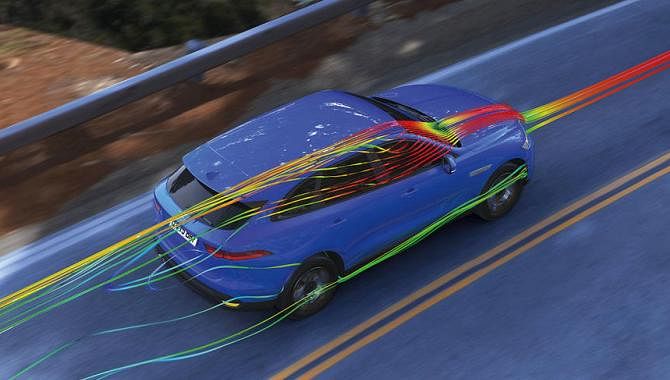Aerodynamics: Why carmakers prefer virtual testing than a wind tunnel
The Jaguar F-Pace is the latest model to ditch wind tunnels in favour of computer simulations to reduce drag; it saves money
Manufacturers are moving away from wind tunnel testing and opting to use virtual simulation techniques instead in their quest to reduce aerodynamic drag.
By switching to computer simulations, engineers can model a car’s aerodynamics without even building one.
Virtual simulation techniques are not only quicker and less costly than using a wind tunnel but also yield better results.
One company, Exa, produces a software package called Powerflow that has now been adopted by many leading car makers, including Tesla, Jaguar Land Rover, BMW, Ford and Volkswagen. The package was used on Jaguar’s most aerodynamic production cars to date, the XE and XF, as well as the F-Pace.
Also read: Ford debuts world’s first mobile aero-acoustic wind tunnel
The XE was the first Jaguar whose aerodynamics were modelled entirely in a virtual environment, a feat involving 1200 computer simulations.
Tesla is also using Exa’s software. Tesla CEO Elon Musk has set a low drag coefficient target of 0.21 for the Model 3, due next year. This undercuts rivals such as the MercedesBenz C-Class (0.24), BMW 3 Series (0.27) and XE (0.26).
The ultimate goal of the industry is to cut out the building of physical prototypes altogether and go straight from virtual modelling inside a computer to a final, physical production vehicle.
One of the main advantages is that the software can immediately highlight where the aerodynamic shortfalls are in a design, whereas poor wind tunnel results can leave engineers scratching their heads as to the exact cause.
An Exa spokesman said: “The use of this technology gives a more accurate analysis of performance in real-world conditions and provides actionable feedback on how to improve the design, something not possible with traditional testing methods.”
Exa claims Powerflow’s simulations are accurate to an equivalent of Cd=0.001. By comparison, traditional wind tunnel tests get to within only Cd=0.003.
So the difference between the virtual method and the wind tunnel method is equivalent to a 5% difference in fuel consumption.

Exa also says there can be a 10% difference between wind tunnel and real-world test results. A virtual environment allows manufacturers to develop sophisticated aerodynamic elements more quickly.
Typical examples are air curtains, active shutters to open drag creating cooling apertures only when necessary, aerodynamic tabs to cut noise and drag and lift-reducing underbody profiles. The battle is now on to get below the tantalising figure of Cd=0.2 for mainstream production cars.
So far, only concepts such as the Mercedes Concept IAA (Cd=0.19) and the low-volume production Volkswagen XL1 (Cd=0.189) have managed to achieve this.
Drag reduction: the early years
Efficient aerodynamics are a major factor in car design, influencing fuel economy, emissions and range.
That’s because aerodynamic drag is a powerful force that increases with the square of the speed, so as the speed doubles, drag quadruples.
The use of ultra-slippery shapes for cars can be traced back to the early 20th century. Designers understood early on that air passing over a blunt shape detaches at the rear, causing low pressure and literally sucking the car backwards.
Lengthening and streamlining reduces that effect; an early example of that is the 1934 Chrysler Airflow. But huge teardrop shapes are impractical in car parks and, in 1936, Wunibald Kamm invented the Kamm tail by snipping off the end of the teardrop.
The ‘Kamm effect’ created prevents the air from detaching, reducing drag. These two features have endured through to modern hatchbacks, and influences of both can be seen in the Mercedes Concept IAA and the Volkswagen XL1.
In the 1980s, the Audi 100 boasted what was, for a production car, a groundbreaking drag coefficient of 0.30 and, today, slippery aerodynamics are top of the agenda for all manufacturers.
You may like: SURFACE TO AIR by Michael Augustin, senior aerodynamicist at Horiba-MIRA
Source: Autocar UK
RELATED ARTICLES
Car Launches and Reveals in May 2025
No SUVs this time, but a new MPV, an electric sportscar and two new hatchbacks are in the pipeline.
CVs in FY25: On The Slow Road To Recovery
The commercial vehicle sector witnessed a mixed performance in FY25, led by buses with a 15% growth, and declines in bot...
Explainer: The Missing Inventory at Ramkrishna Forgings, and its Significance
Ramkrishna Forgings faces scrutiny after uncovering inventory discrepancies during its annual audit, prompting an extern...






 12 Jul 2016
12 Jul 2016
 11066 Views
11066 Views





 Autocar India
Autocar India


 Shahkar Abidi
Shahkar Abidi


